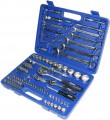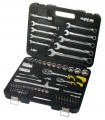Socket heads sizes (6 points)
Working size range of hex sockets (see above) supplied with the kit. This parameter allows you to evaluate how the heads fit the dimensions of the fasteners with which they are planned to be used.
Adapter
An adapter for docking seemingly incompatible elements from a set. For example, socket heads with an unsuitable landing square on a ratchet, screwdriver handle or in a drill driver.
The adapter provides full-fledged work with all the required list of tools from the set.
Extension
The type of extension included with the tool kit.
Extensions refer to "intermediate" devices, if necessary, installed between the main tool (like a screwdriver handle, see above) and the working nozzle. As the name implies, they allow you to increase the length of the working part of the tool — for example, to get to hard-to-reach places. Here are the main options for such devices:
—
Hard. Rigid rod extension. It does not give such freedom of action and the ability to get to hard-to-reach places as flexible (see below), but it is considered more reliable, allows you to develop great efforts (often the same as when working without an extension cord) and even allows the use as an improvised lever. Some rigid extensions may also have a crank function (see above).
—
Flexible. An extension in the form of a flexible tube, usually made of a metal spiral. Such an extension, like a universal joint (see above), allows you to position the nozzle at an angle to the axis of rotation of the main tool — while the range of such angles is much wider (in some cases they can reach 180 °), and the long length and high mobility of the device are even more expands freedom of action. The disadvantage of flexible extensions is less suitability for work with greater efforts than the rigid ones described above.
— Rigid/flexible. This option is indicated for sets equipped with both types of
...extensions described above. This makes it possible to choose an option depending on the specific situation.
If there are several extensions of the same type in the kit, they, usually, differ in the size of the attachment (see "Landing square").Wrench sizes
Dimensions of the wrenches supplied in the set. Specified as a range — from the minimum to the maximum size. In this case, the specific distribution of different types of keys over the range may be different. An example is the following set: 17 open-end wrenches, 5 box wrenches, size range 6 – 24 mm. In such a set, box wrenches are almost guaranteed not to cover the entire range of sizes, but for open-end wrenches, this is quite likely. Such details can be specified separately.
Also note that a wrench size of
24mm or more is considered quite large for today's general purpose tools. However, on the market you can find sets that include wrenches for
27 mm,
30 mm and even
32 mm.
Also in kit
Additional items included with the toolbox but not listed above. Here are some of those items:
— Adapter. Adapter from one type of mount to another. Quite often, adapters are designed to fit magnetic bits (see above) with a hex shank into a tool that uses a landing square, but there may be other options — for example, adapters between different sizes of the mentioned squares (see above).
— Holder for bits. A specific type of adapter designed to mount bits with a conventional hex shank in screwdrivers where a shank with a notch for a retainer is required. In extreme cases, they can also be used as improvised screwdrivers. Several holders can be supplied, in such cases they usually differ in length.
— Level. A tool for assessing the position of a particular surface. The simplest levels are for testing whether a surface is horizontal or not; however, tool kits usually include more advanced fixtures that allow you to also control verticality, and in some cases also check compliance with a 45 ° tilt and even measure a specific angle of deviation from the horizontal / vertical.
— Depth limiters. They are used together with drills (see above). They allow you to set the maximum drilling depth — the tool simply will not go further; this is useful in cases where you need to make holes of a given depth.
— Telescopic magnetic probe. A device in the form of an extendable rod (like an antenna or a pointer) with a strong permanent magnet at...the end. Facilitates the collection of small metal parts — for example, crumbled bolts or bits — including and in hard-to-reach places (like the space under the cabinet or a narrow gap between the boards).
— Lamp. Classic flashlight for lighting in dark places.
— Tester. He's an indicator. A specialized screwdriver for searching for a phase in electrical networks during electrical work. The indicator rod is almost completely covered with insulation, and a light bulb is located in the transparent handle. Such a device can also be used as a classic screwdriver, but it is not designed for applying great efforts — the main purpose is to search for the phase.
— Fastening devices — for example, screws with dowels. In normal cases, it is more convenient to buy fasteners separately, for specific needs; however, there are situations when the "emergency stock" provided in the kit is very handy.
This list is not exhaustive — manufacturers may provide other equipment, sometimes very specific.

